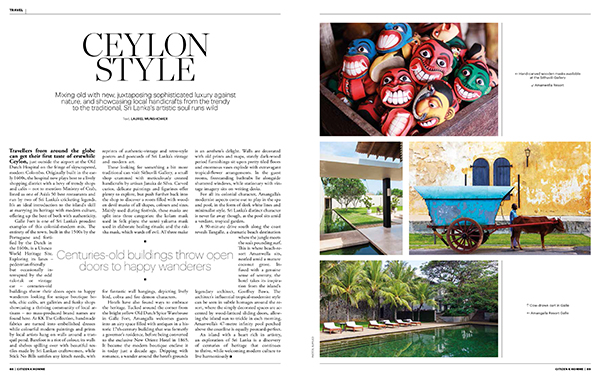Travellers from around the globe can get their first taste of erstwhile Ceylon, just outside the airport at the Old Dutch Hospital on the fringe of skyscrapered, modern Colombo. Originally built in the early 1600s, the hospital now plays host to a lively shopping district with a bevy of trendy shops and cafés – not to mention Ministry of Crab, listed as one of Asia’s 50 Best Restaurants and run by two of Sri Lanka’s cricketing legends. It’s an ideal introduction to the island’s skill at marrying its heritage with modern culture, offering up the best of both with authenticity.
Galle Fort is one of Sri Lanka’s proudest examples of this colonial-modern mix. The entirety of the town, built in the 1500s by the Portuguese and fortified by the Dutch in the 1600s, is a Unesco World Heritage Site. Exploring its lanes – pedestrian-friendly but occasionally interrupted by the odd tuk-tuk or vintage car – centuries-old buildings throw their doors open to happy wanderers looking for unique boutique hotels, chic cafés, art galleries and funky shops showcasing a thriving community of local artisans – no mass-produced brand names are found here. At KK The Collection, handmade fabrics are turned into embellished dresses while colourful modern paintings and prints by local artists hang on walls around a tranquil pond. Barefoot is a riot of colour, its walls and shelves spilling over with beautiful textiles made by Sri Lankan craftswomen, while Stick No Bills satisfies any kitsch needs, with reprints of authentic-vintage and retro-style posters and postcards of Sri Lanka’s vintage and modern art.
Those looking for something a bit more traditional can visit Sithuvili Gallery, a small shop crammed with meticulously created handicrafts by artisan Janaka de Silva. Carved curios, delicate paintings and figurines offer plenty to explore, but push further back into the shop to discover a room filled with wooden devil masks of all shapes, colours and sizes. Mainly used during festivals, these masks are split into three categories: the kolam mask used in folk plays; the sanni yakuma mask used in elaborate healing rituals; and the raksha mask, which wards off evil. All three make for fantastic wall hangings, depicting lively bird, cobra and fire demon characters.
Hotels have also found ways to embrace the heritage. Tucked around the corner from the bright yellow Old Dutch Spice Warehouse in Galle Fort, Amangalla welcomes guests into an airy space filled with antiques in a historic 17th-century building that was formerly a governor’s residence, before being converted to the exclusive New Orient Hotel in 1865. It became the modern boutique enclave it is today just a decade ago. Dripping with romance, a wander around the hotel’s grounds is an aesthete’s delight. Walls are decorated with old prints and maps, stately dark-wood period furnishings sit upon pretty tiled floors and enormous vases explode with extravagant tropical-flower arrangements. In the guest rooms, freestanding bathtubs lie alongside shuttered windows, while stationary with vintage imagery sits on writing desks.
For all its colonial character, Amangalla’s modernist aspects come out to play in the spa and pool, in the form of sleek white lines and minimalist style. Sri Lanka’s distinct character is never far away though, as the pool sits amid a verdant, tropical garden.
A 90-minute drive south along the coast reveals Tangalle, a dramatic beach destination where the jungle meets the sea’s pounding surf. This is where beach-resort Amanwella sits, nestled amid a mature coconut grove. Infused with a genuine sense of serenity, the hotel takes its inspiration from the island’s legendary architect, Geoffrey Bawa. The architect’s influential tropical-modernist style can be seen in subtle homages around the resort, where the simply decorated spaces are accented by wood-latticed sliding doors, allowing the island sun to trickle in each morning. Amanwella’s 47-metre infinity pool perched above the coastline is equally postcard-perfect.
An island with a heart rich in artistry, an exploration of Sri Lanka is a discovery of centuries of heritage that continues to thrive, while welcoming modern culture to live harmoniously.
*This story was originally published in Citizen K Arabia Homme, winter 2016/17.

Really enjoyed this. My parents are actually from Sri Lanka, I’ve never been so this is some greatly worded insight.
I’m glad you enjoyed! I hope you have the opportunity to visit one day, it’s really beautiful!
Sounds like a great place to visit! Thanks for sharing! 🙂
Yes, it’s an absolute must-do if you have the chance!
Really cool that you have been to so Many cool places … To be young again…. Keep going
Thank you! I hope to never stop!
I think I loved it as much as you! Here’s my experience of Sri Lanka https://beachbuminbkk.wordpress.com/2017/03/27/in-awe-of-sri-lanka/
I love this! This is definitely a place on my bucket list!! Thanks for sharing 🙂
Kind regards